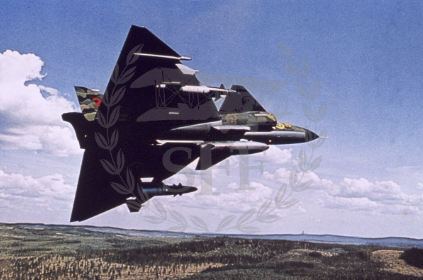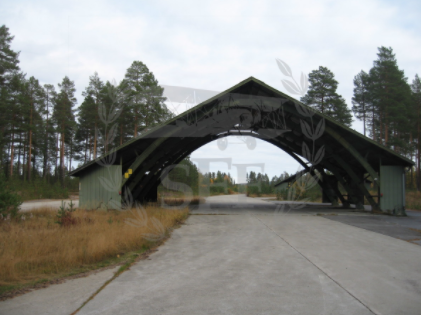Viggen road base
Viggen
The Vig that stands here is an AJ 37, i.e. the attack version of Viggen. The Viggen was developed primarily to replace the A 32 Lansen, which had been in service since the mid-1950s.
The Viggen prototype flew for the first time on February 8, 1967, and the aircraft entered service with the Air Force in June 1971. On November 25, 2005, the last operational flight of the Viggen was flown in the Air Force. However, some Sk 37s were retained for training in electronic warfare, but the last flight for this purpose was in June 2007. Two Viggens are still kept in airworthy condition by the Swedish Air Force Historic Flight, one AJS 37 and one Sk 37. A total of 329 Viggens were built , all versions included.

Airplane 37 Viggen. Image from the Swedish Aviation History Association.
Some data about the AJ 37 Viggen
Engine: Volvo Aviation Engine RM8A
Crew: 1 person
Length: 16.30 m
Span: 10.60 m
Max weight: 20,450 kg
Max Speed: Mach 2.0
Armament: Rockets, Bombs, Naval Targeting Robots, Fighter Robots
Road bases
In the mid-50s, a new philosophy was developed for how the aircraft would be protected from attack while on the ground. The previous philosophy of protecting the aircraft in large rock or concrete hangars was both expensive and no longer safe given the increasingly powerful nuclear warheads available. The philosophy instead became that the aircraft would be spread out on a large number of air bases across the country. These air bases had one main runway and two, perhaps three, reserve runways. Adjacent to the runway there was a Framom (forward clearing area) where the standby fighter was refueled and loaded and then stood on high alert. At a little further distance from the runway, about 2 km, there was a Bakom (rear clearing area) where attack and reconnaissance aircraft could be made ready for their missions. At an even greater distance, about 5-6 km, there was a Uom (staging area) where aircraft that had no immediate task could be lined up. To provide rain protection and to some extent also wind protection during refueling and loading, the aircraft were lined up in so-called “Töreboda bows”. The toreboda arches also provided some visibility protection against enemy reconnaissance. The crib on this diorama is set up in such a Töreboda arch.

Töreboda arch. Image from the Swedish Aviation History Association.
